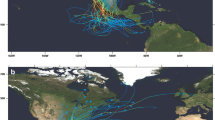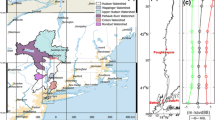Abstract
The incidence of major storm surges in the last decade have dramatically emphasized the immense destructive capabilities of extreme water level events, particularly when driven by severe tropical cyclones. Given this risk, it is vitally important that the exceedance probabilities of extreme water levels are accurately evaluated to inform risk-based flood and erosion management, engineering and for future land-use planning and to ensure the risk of catastrophic structural failures due to under-design or expensive wastes due to over-design are minimised. Australia has a long history of coastal flooding from tropical cyclones. Using a novel integration of two modeling techniques, this paper provides the first estimates of present day extreme water level exceedance probabilities around the whole coastline of Australia, and the first estimates that combine the influence of astronomical tides, storm surges generated by both extra-tropical and tropical cyclones, and seasonal and inter-annual variations in mean sea level. Initially, an analysis of tide gauge records has been used to assess the characteristics of tropical cyclone-induced surges around Australia. However, given the dearth (temporal and spatial) of information around much of the coastline, and therefore the inability of these gauge records to adequately describe the regional climatology, an observationally based stochastic tropical cyclone model has been developed to synthetically extend the tropical cyclone record to 10,000 years. Wind and pressure fields derived for these synthetically generated events have then been used to drive a hydrodynamic model of the Australian continental shelf region with annual maximum water levels extracted to estimate exceedance probabilities around the coastline. To validate this methodology, selected historic storm surge events have been simulated and resultant storm surges compared with gauge records. Tropical cyclone induced exceedance probabilities have been combined with estimates derived from a 61-year water level hindcast described in a companion paper to give a single estimate of present day extreme water level probabilities around the whole coastline of Australia. Results of this work are freely available to coastal engineers, managers and researchers via a web-based tool (www.sealevelrise.info). The described methodology could be applied to other regions of the world, like the US east coast, that are subject to both extra-tropical and tropical cyclones.

















Similar content being viewed by others
References
Bindoff NL, Willebrand J, Artale V, Cazenave A, Gregory J, Gulev S, Hanawa K, Le Quéré C, Levitus S, Nojiri Y, Shum CK, Talley LD, Unnikrishnan A (2007) Observations: Oceanic climate change and sea level. In: Climate change 2007: the physical science basis. In: Solomon S, Qin D, Manning M, Chen Z, Marquis M, Averyt KB, Tignor M, Miller HL (eds) Contribution of working group I to the Fourth Assessment Report of the Intergovernmental Panel on Climate Change. Cambridge University Press, Cambridge, United Kingdom and New York, NY, USA, pp 385–432
Cardone VJ, Cox AT, Greenwood JA, Thompson EF (1994) Upgrade of tropical cyclone surface wind field model. Miscellaneous Paper, CERC-94-14, prepared for U.S. Army Corps of Engineers (101 pp)
Church JA, Gregory JM, White NJ, Platten SM, Mitrovica JX (2011) Understanding and projecting sea level change. Oceanography (J Oceanogr Soc) 24(2):130–143
Colberg F, McInnes KL (2012) The impact of storminess changes on extreme sea levels over southern Australia. JGR-Oceans, doi:10.1029/2012JC007919.
Coles S (2001) An introduction to statistical modelling of extreme values. Springer, Berlin 207 pp
Danish Hydraulic Institute (2013) Mike 21 & Mike 3 flow model FM. Hydrodynamic and transport module scientific documentation. http://www.dhisoftware.com/Download/DocumentsAndTools/~/media/Microsite_MIKEbyDHI/Publications/PDF/Short%20descriptions/MIKE213_FM_HD_Short_Description.ashx
Egbert GD, Erofeeva S (2002) Efficient inverse modeling of barotropic ocean tides. J Atmos Ocean Technol 19(2):183–204
Eliot M, Pattiaratchi C (2010) Remote forcing of water levels by tropical cyclones in southwest Australia. Cont Shelf Res 30(14):1549–1561
Georgiou PN, Davenport AG, Vickery BJ (1983) Design wind speeds in regions dominated by tropical cyclones. J Wind Eng Ind Aerodyn 13:139–152
Grinsted A, Moore JC, Jevrejeva S (2010) Reconstructing sea level from paleo and projected temperatures 200–2100 ad. Clim Dyn 34(4):461–472
Haigh ID, Wijeratne EMS, MacPherson LR, Pattiaratchi CB, George S (2013) Estimating present day extreme total water level exceedance probabilities around the coastline of Australia: tides, extra-tropical storm surges and mean sea level. Clim Dyn. doi:10.1007/s00382-012-1652-1
Haigh ID, Pattiaratchi C (2010) 21st century changes in extreme sea levels around Western Australia. In: Proceedings of the 17th National Australian Meteorological & Oceanographic Society Conference, Canberra, Australia
Haigh ID, Nicholls RJ, Wells NC (2011) Rising sea levels in the english channel 1900–2100. Proc ICE Marit Eng 164(2):81–92
Hardy TA, McConochie JD, Mason LB (2003) Modeling tropical cyclone wave population of the Great Barrier Reef. J Waterway Port Coastal Ocean Eng 129:104–113
Harper BA (ed) (2001) Queensland climate change and community vulnerability to tropical cyclones—ocean hazards assessment stage 1—review of technical requirements. Report prepared by Systems Engineering Australia Pty Ltd in association with James Cook University Marine Modelling Unit, Queensland Government, 375 pp, March 2001
Harper BA, Holland GJ (1999) An updated parametric model of the tropical cyclone. In: 23rd conference on hurricanes and tropical meteorology, 893–896
Harper BA, Stroud SA, McCormack M, West S (2008) A review of historical tropical cyclone intensity in northwestern Australia and implications for climate change trend analysis. Aust Meteorol Mag 57:121–141
Harper B, Hardy T, Mason L, Fryar R (2009) Developments in storm tide modelling and risk assessment in the Australian region. Nat Hazards 51:225–238
Holland GJ (1980) An analytic model of the wind and pressure profiles in hurricanes. Mon Weather Rev 108:1212–1218
Holland GJ (1981) On the quality of the Australian tropical cyclone data base. Aust Meteorol Mag 29:169–181
Holmes JD (2001) Wind loading of structures. Spon Press, London 356 pp
Horsburgh KL, Wilson C (2007) Tide-surge interaction and its role in the distribution of surge residuals in the North Sea. J Geophys Res 112:CO8003
Horton R, Herweijer C, Rosenzweig C, Liu J, Gornitz V, Ruane AC (2008) Sea level rise projections for current generation CGCMs based on the semi-empirical method. Geophys Res Lett 35(2):L02715
Hunter J (2010) Estimating sea-level extremes under conditions of uncertain sea-level rise. Clim Change 99(3):331–350
Hunter J (2011) A simple technique for estimating an allowance for uncertain sea-level rise. Clim Change. doi:10.1007/s10584-011-0332-1
James MK, Mason LB (2005) Synthetic tropical cyclone database. J Waterw Port Coastal Ocean Eng 131(4):181–192
Jevrejeva S, Moore JC, Grinsted A (2010) How will sea level respond to changes in natural and anthropogenic forcings by 2100? Geophys Res Lett 37(7):L07703
Kaplan J, DeMaria M (1995) A simple empirical model for predicting the decay of tropical cyclone winds after landfall. J Appl Meteorol 34:2499–2512
Kepert J (2001) The dynamics of boundary layer jets within the tropical cyclone core. Part 1: linear Theory. J Atmos Sci 58:2469–2484
Kistler R, Kalnay E, Collins W, Saha S, White G, Woollen J, Chelliah M, Ebisuzaki W, Kanamitsu M, Kousky V, Dool H, Jenne R, Fiorino M (2001) The NCEP-NCAR 50-year Reanalysis: monthly Means CD ROM and documentation. Bull Am Meteorol Soc 82(2):247–267
Lowe JA, Woodworth PL, Knutson T, McDonald RE, McInnes K, Woth K, Von Storch H, Wolf J, Swail V, Bernier N, Gulev S, Horsburgh K, Unnikrishnan AS, Hunter J, Weisse R (2010) Past and future changes in extreme water levels and waves. In: Church JA, Woodworth PL, Aarup T, Wilson S (eds) Understanding sea-level rise and variability. Wiley-Blackwell, Oxford
McConochie JD, Mason LB, Hardy TA (1999) A Coral Sea cyclone wind model intended for wave modelling. In: Proceedings of 14th conference on coastal and ocean engineering, IEAust, Perth, pp 413–418
McConochie JD, Hardy TA, Mason LB (2004) Modelling tropical cyclone over-water wind and pressure fields. Ocean Eng 31:1757–1782
McInnes KL, Walsh KJE, Hubbert GD, Beer T (2003) Impact of sea-level rise and storm surges on a coastal community. Nat Hazards 30(2):187–207
McInnes KL, Macadam I, Hubbert GD, O'Grady JD (2009) A modelling approach for estimating the frequency of sea level extremes and the impact of climate change in southeast Australia. Nat Hazards 51:115–137
McInnes KL, Macadam I, Hubbert GD, O’Grady JG (2011a) An assessment of current and future vulnerability to coastal inundation due to sea level extremes in Victoria, southeast Australia. Int J Clim. doi:10.1002/joc.3405
McInnes KL, O’Grady JG, Hemer M, Macadam I, Abbs DJ, White CJ, Bennett JC, Corney SP, Holz GK, Grose MR, Gaynor SM, Bindoff NL (2011b) Climate future for Tasmania: Extreme tide and sea-level events. Technical Report, Antarctic Climate and Ecosystems Corporate Research Centre
Meehl GA, Stocker TF, Collins WD, Friedlingstein P, Gaye AT, Gregory JM, Kitoh A, Knutti R, Murphy JM, Noda A, Raper SCB, Watterson IG, Weaver AJ, Zhao ZC (2007) Global climate projections. In: Solomon S, Qin D, Manning M, Chen Z, Marquis M, Averyt KB, Tignor M, Miller HL (eds) Climate change 2007: The physical science basis. Contribution of working group I to the Fourth Assessment Report of the Intergovernmental Panel on Climate Change. Cambridge University Press, Cambridge, United Kingdom and New York, NY, USA, pp 747–845
Menéndez M, Woodworth PL (2010) Changes in extreme high water levels based on a quasi-global tide-gauge dataset. J Geophys Res 115(C10):C10011
Nicholls RJ, Marinova N, Lowe JA, Brown S, Vellinga P, de Gusmao D, Hinkel J, Tol RSJ (2011) Sea-level rise and its possible impacts given a ‘beyond 4°C world’ in the twenty-first century. Philos Trans R Soc A Math Phys Eng Sci 369(1934):161–181
Nott J, Hayne M (2000) How high was the storm surge from tropical cyclone Mahina. Aust J Emerg Manag 15:11–13
O’Grady JG, McInnes KL (2010) Extreme wind waves and their relationship to storm surges in northeastern Bass Strait. Aust Meteorol Oceanogr J 60:265–275
Pawlowicz R, Beardsley B, Lentz S (2002) Classical tidal harmonic analysis including error estimates in MATLAB using T_TIDE. Comput Geosci 28(8):929–937
Pugh DT (2004) Changing sea levels: effects of tides, weather and climate. Cambridge University Press, Cambridge, United Kingdom, 280 pp
Rahmstorf S (2007) A semi-empirical approach to projecting future sea-level rise. Science 315(5810):368–370
Seneviratne SI, Nicholls N, Easterling D, Goodess CM, Kanae S, Kossin J, Luo Y, Marengo J, McInnes K, Rahimi M, Reichstein M, Sorteberg A, Vera C, Zhang X (2012) Changes in climate extremes and their impacts on the natural physical environment. In: Managing the Risks of Extreme Events and Disasters to Advance Climate Change Adaptation. Editors: Field CB, Barros V, Stocker TF, Qin D, Dokken DJ, Ebi KL, Mastrandrea MD, Mach KJ, Plattner GK, Allen SK, Tignor M, Midgley PM. A Special Report of Working Groups I and II of the Intergovernmental Panel on Climate Change (IPCC). Cambridge University Press, Cambridge, UK, and New York, NY, USA, pp 109–230
Simiu E, Scanlan RH (1986) Wind effects on structures, 2nd edn. Wiley-Interscience, New York
Uhlhorn EW, Black PG, Franklin JL, Goodberlet M, Carswell J, Goldstein AS (2007) Hurricane surface wind measurements from an operational stepped frequency microwave radiometer. Mon Weather Rev 135:3070–3085
Vermeer M, Rahmstorf S (2009) Global sea level linked to global temperature. Proc Natl Acad Sci 106:21527
Vickery PJ, Skerlj PF, Twisdale LA (2000) Simulation of hurricane risk in the U.S. using empirical track model. J Struct Eng 126(10):1222–1237
Woodworth PL, Blackman DL (2004) Evidence for systematic changes in extreme high waters since the mid-1970s. J Clim 17(6):1190–1197
Acknowledgments
We would like to thank the Australian National Tidal Centre, Western Australian Department of Transport, Sydney Ports Corporation and Fremantle Ports for supplying the tide-gauge datasets, Tessa Jakszewicz for managing the project, and Matthew Eliot for useful discussions regarding the study. We would also like to acknowledge Kathleen McInnes, Robert Nicholls, Thomas Wahl and Phil Watson whose helpful comments and suggestions greatly improved the final paper. This study was funded by the Australian Department of Climate Change and Energy Efficiency and the Western Australian Department of Transport, and builds on an earlier study funded by the Western Australian Marine Science Institution.
Author information
Authors and Affiliations
Corresponding author
Rights and permissions
About this article
Cite this article
Haigh, I.D., MacPherson, L.R., Mason, M.S. et al. Estimating present day extreme water level exceedance probabilities around the coastline of Australia: tropical cyclone-induced storm surges. Clim Dyn 42, 139–157 (2014). https://doi.org/10.1007/s00382-012-1653-0
Received:
Accepted:
Published:
Issue Date:
DOI: https://doi.org/10.1007/s00382-012-1653-0




